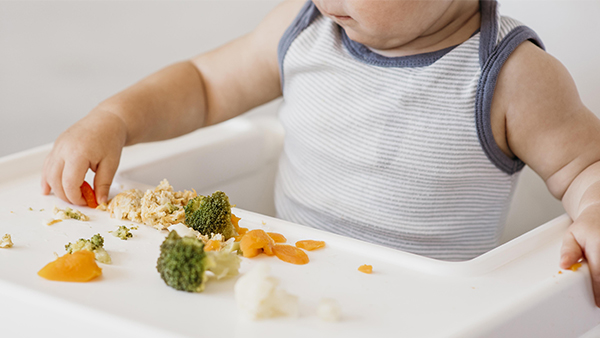BLW - the baby is in control
The most common way of introducing food to a baby has traditionally been to give smooth purees and gradually increase the amount. But there are also other ways, such as Baby–Led Weaning. This is a method that involves the baby approaching the food itself by being offered grip-friendly pieces of, for example, soft-cooked or oven-baked food. Here are the most important things you need to know if you want to try it.
Read time: 5 m
Verified by Sara Ask
Licensed dietitian
When can I start?
A prerequisite for being able to start with the BLW method is that the baby has sufficiently developed motor skills to be able to eat on its own. This means that the baby needs to be able to sit up in a high chair or on your lap, able to keep their head upright and be able to grab the food, bring it to their mouth and 'chew' by pressing it against the palate and then swallowing. Lots of babies are ready for this when they are 6 months old, which is also around when it's time to start tasting food. It can take a bit longer for others.
What should I give my baby?
The size of the food should be about the same as a french fry, large enough for the baby to be able to hold the food in their hand and chew on what's sticking out. Some examples:
- Soft-cooked foods, such as broccoli, root vegetables, potatoes, or eggs. A little rapeseed oil or other liquid fat on the vegetables emphasizes the taste and is a good source of fat. Read more about fat here.
- Baked food, such as salmon, cod, or other fish easily falls apart into pieces in the mouth.
- Tofu.
- Soft, peeled fruits, such as banana, soft pear, soft mango, and avocado.
- Porridge fingers, i.e. homemade bars of iron-enriched porridge, are easy for the baby to hold in their hand. Read more about iron here.
- Small sandwiches - bread and butter, pate, hummus, or other toppings that are easy to eat.
Because it can take some time for the baby to start eating sufficiently large amounts of food, breast milk or formula/supplement nutrition is a safe base throughout the first year of life - or longer for those who want to. It's easy to believe that breast milk at this point is weak and doesn't contain any nutrients, but it still contributes a lot of nutrition.
Won't my baby choke?
Perhaps the most common question when the BLW method comes up is whether or not there is a risk that the baby will choke - a completely natural fear. But the research so far doesn't indicate that babies who follow the BLW method choke more often than others. However, they sometimes try to swallow a slightly too large piece of food with the result that they gag. Then the baby's innate protection against choking means that the food comes back up again. If this happens - try to wait a bit before you intervene, to see if the baby can solve it on its own. Gagging from time to time is a normal step in learning how to eat.
Good rules of thumb for stopping your baby from choking, no matter how you're feeding them:
- Avoid hard foods and smooth, round shapes, such as round sausage pieces (cut the sausage lengthwise!), Hard pieces of fruit or vegetables, whole nuts, grapes, cherry tomatoes, and other things that can get stuck in the baby's throat.
- Make sure the baby is sitting upright.
- Never leave the baby alone.
Advantages and disadvantages of the BLW method
Parents who like the BLW method tend to be very positive about it, as they feel that the baby gets to be an active eater. But there are always positives and negatives.
+ The baby gets to control what they eat themselves, which they usually like.
+ Easier for the baby to eat the same food as the rest of the family - often there is something that can be BLW-adapted.
+ Some research suggests that the method may reduce the risk of later food problems.
− It doesn't suit everyone. For children who have weak muscles or are late with their motor development, for example, it's not as suitable.
− It's difficult to know exactly what the baby has eaten. On the other hand, there's nothing you need to keep a close eye on as long as the baby grows as it should and is well.
− If the baby is temporarily ill and lethargic, it can be difficult for it to be able to pick up enough food on its own. You might need to feed them.
It's like all methods, sometimes you need to be flexible and change things to meet the baby's needs here and now.
Verified by Sara Ask
Licensed dietitian
More from Preggers
Hundreds of related articles, podcasts & more waiting for you in the Preggers app.
Download Preggers today.

